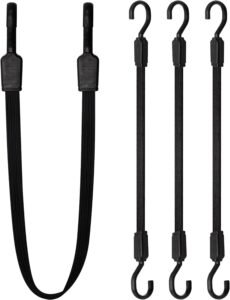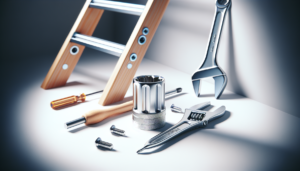So you’ve invested in a trusty ladder rack to make your work and travel easier, but now you’re wondering how to keep it in top-notch condition for years to come. Well, fret not! This article is here to guide you through the simple steps to maintain and clean your ladder rack, ensuring its longevity and functionality. From removing dirt and debris to inspecting for any damaged parts, we’ve got you covered. Let’s dive in and learn how to give your ladder rack the TLC it deserves!
Inspecting Your Ladder Rack
Visual Inspection
Regular visual inspections of your ladder rack are essential to ensure its safety and longevity. Take a few moments to carefully examine the rack for any signs of damage or wear. Look for cracks, dents, or bent components. Check all the joints and connections to ensure they are secure and free from any signs of stress. Pay close attention to the bolts and fasteners, as any looseness could compromise the stability of the rack. By conducting a visual inspection before and after each use, you can promptly identify any potential issues and address them before they worsen.
Checking for Damage
In addition to the visual inspection, it’s important to thoroughly check for any damage to your ladder rack. Examine each component closely, including the crossbars, side rails, and attachment points. Look for signs of rust, corrosion, or any other form of deterioration. If you notice any damage, address it promptly to prevent further harm and to maintain the structural integrity of the rack. It’s always better to be cautious and repair or replace any damaged parts before they become a safety hazard.
Tightening Loose Bolts
One of the most common issues with ladder racks is the loosening of bolts and fasteners over time. To ensure the stability of your rack, regularly check and tighten all the bolts and fasteners. Use a wrench or socket set to securely tighten any loose connections. It’s important not to overtighten, as this can lead to damage. A good rule of thumb is to tighten the bolts just enough to eliminate any play or movement in the joints. By regularly tightening loose bolts, you can prevent the rack from becoming wobbly or unstable during use.
Replacing Worn-out Parts
As with any equipment, ladder racks are subject to wear and tear over time. To maintain the integrity of your rack and extend its lifespan, it’s crucial to replace any worn-out or damaged parts. Whether it’s worn-out crossbars, corroded attachment points, or frayed straps, promptly replacing these components will ensure that your ladder rack remains safe to use. Consult the manufacturer’s guidelines or contact a reputable dealer to source genuine replacement parts. Investing in high-quality replacements will guarantee the continued functionality of your ladder rack.
Cleaning Your Ladder Rack
Removing Dust and Debris
Dust and debris can accumulate on your ladder rack, causing it to look unsightly and potentially leading to corrosion. Regularly remove any dust and debris by using a soft-bristle brush or a vacuum cleaner with a brush attachment. Pay attention to hard-to-reach areas, such as the corners and crevices, as they tend to accumulate more dirt. By keeping your ladder rack free from dust and debris, you not only maintain its appearance but also prevent any potential damage caused by trapped moisture.
Washing with Mild Soap
Periodically washing your ladder rack with mild soap and water is an effective way to remove grime and dirt. Start by rinsing the rack with clean water to remove loose dirt particles. Then, using a sponge or soft cloth, gently scrub the rack with a solution of mild soap and water. Avoid using harsh detergents or abrasive cleaners, as they can cause damage to the finish. Rinse thoroughly with water and dry the rack completely to prevent water spots or streaks. This simple cleaning routine will help keep your ladder rack looking clean and fresh.
Removing Rust and Corrosion
If you notice any rust or corrosion on your ladder rack, it’s vital to remove it promptly to prevent further damage. Begin by scrubbing the affected areas with a wire brush to loosen and remove the rust. For stubborn rust stains, you can also use sandpaper or a rust remover product. Once the rust is removed, rinse the rack with water and dry it thoroughly. To provide additional protection against future corrosion, consider applying a rust inhibitor or primer to the affected areas as a preventive measure.
Applying Protective Coating
To further enhance the lifespan of your ladder rack, consider applying a protective coating. There are various options available, such as clear coats, wax, or specialized protective sprays. These coatings act as a barrier, shielding your rack from environmental factors like UV rays, moisture, and harsh chemicals. Follow the manufacturer’s instructions carefully when applying the coating, ensuring an even and thorough coverage. By regularly applying a protective coating, you can keep your ladder rack in excellent condition and prolong its lifespan.
Maintaining Proper Weight Capacity
Knowing the Load Capacity
Understanding the load capacity of your ladder rack is crucial for safe usage. Refer to the manufacturer’s guidelines or user manual to determine the maximum weight that your rack can support. Never exceed this limit, as it can lead to structural failure and accidents. If you frequently carry heavy loads, consider investing in a ladder rack with a higher weight capacity. This ensures that you can transport your equipment or materials safely without putting undue stress on the rack.
Avoiding Overloading
While it can be tempting to maximize your ladder rack’s storage capacity, avoid the temptation to overload it. Overloading not only compromises the stability and structural integrity of the rack but also increases the risk of accidents and damage to your vehicle. Distribute the weight evenly across the crossbars and avoid concentrating excessive weight on certain areas. By adhering to the weight capacity guidelines and avoiding overloading, you can maintain the long-term performance and safety of your ladder rack.
Balancing the Weight Distribution
Proper weight distribution is essential for maintaining stability during transportation. When loading your ladder rack, ensure that the weight is evenly distributed on both sides. Imbalanced weight distribution can lead to swaying or rocking of the rack, potentially causing accidents or damage. Take the time to position your equipment or materials carefully, evenly distributing the weight across the rack. If necessary, use straps or bungee cords to secure the load and prevent any movement or shifting during transit.
Protecting Against Harsh Weather
Covering the Rack When Not in Use
When your ladder rack is not in use, it’s best to protect it from the elements by covering it. Invest in a durable cover specifically designed to fit your ladder rack or use a waterproof tarp if a cover is not available. A cover acts as a barrier, shielding your rack from rain, snow, dust, and other environmental factors. By keeping the rack covered when not in use, you minimize the risk of damage caused by exposure to harsh weather conditions.
Repairing Damage from Weather Exposure
Sometimes, despite your best efforts, your ladder rack might sustain damage from exposure to harsh weather conditions. Promptly inspect your rack after severe weather events and assess any visible damage. Repair or replace any damaged components to avoid further deterioration. Look for signs of rust, corrosion, or weakened joints. Addressing weather-related damage promptly will help extend the lifespan of your ladder rack and ensure it remains safe to use.
Using Weatherproof Covers or Sealants
For enhanced protection against harsh weather, consider using weatherproof covers or sealants specifically designed for ladder racks. These products create an additional barrier against moisture, UV rays, and other environmental factors that can cause damage or corrosion. Follow the manufacturer’s instructions for applying the sealant, ensuring thorough coverage. Weatherproof covers are also a great option for safeguarding your rack during prolonged exposure to the elements, such as when parked outdoors for extended periods.
Proper Storage and Handling
Storing the Ladder Rack Indoors
Whenever possible, store your ladder rack indoors to protect it from the elements and reduce the risk of damage. Find a designated storage area, such as a garage or shed, where the rack can be safely stored when not in use. Indoor storage minimizes exposure to rain, snow, UV rays, and extreme temperature fluctuations, all of which can cause deterioration over time. If indoor storage is not feasible, opt for a weatherproof cover to provide some level of protection.
Avoiding Rough Handling
Ladder racks are designed to withstand the rigors of transporting heavy loads, but rough handling can still lead to damage. Avoid dropping or throwing the rack during installation or removal. Treat it with care when attaching or detaching it from your vehicle, ensuring smooth and controlled movements. Rough handling can cause structural damage, bending, or misalignment of components, compromising the rack’s stability and safety during use.
Using Protective Padding
To minimize the risk of scratches or dents, consider using protective padding on your ladder rack. Foam or rubber padding can be applied to the crossbars, side rails, or any other areas that come into contact with your equipment or materials. This padding serves as a cushion, preventing direct contact and reducing the chances of cosmetic or structural damage. Invest in high-quality padding that is durable and resistant to wear and tear.
Properly Securing Ladders
Securing your ladders properly on the rack is essential for safe transportation. Use high-quality ladder straps or bungee cords to secure the ladders and prevent any movement or shifting during transit. Double-check that the straps are tightly secured, but be cautious not to overtighten and potentially damage the ladders or the rack. Ensure that the ladders are properly aligned and positioned on the rack to evenly distribute the weight. By taking these precautions, you can safely transport your ladders without risking damage to the rack or your vehicle.
Maintaining the Ladder Rack’s Paint
Removing Scratches or Chipped Paint
Over time, your ladder rack’s paint may develop scratches or chips due to regular use or accidental bumps. To maintain the appearance of your rack, it’s important to address these cosmetic imperfections promptly. Start by thoroughly cleaning the affected area with mild soap and water. Gently sand the scratched or chipped area using fine-grit sandpaper until it feels smooth. Wipe away any dust or debris, then apply a layer of touch-up paint that matches the original color. Allow the paint to dry completely before using the rack again.
Applying Touch-up Paint
In addition to addressing scratches and chips, consider periodically applying touch-up paint to your ladder rack. This helps protect the underlying metal from rust or corrosion and keeps your rack looking fresh and new. Before applying the touch-up paint, ensure that the surface is clean and free from any dirt or contaminants. Use a small brush or applicator to carefully apply the paint, following the manufacturer’s instructions. Allow sufficient drying time before subjecting the rack to any further use or exposure.
Using Rust Inhibitors
To provide additional protection against rust and corrosion, consider using rust inhibitors on your ladder rack. These products create a barrier that prevents moisture from reaching the metal surface and causing damage. Before applying rust inhibitors, remove any existing rust or corrosion using a wire brush or sandpaper. Once the surface is clean, apply the rust inhibitor according to the manufacturer’s instructions. Regular application of rust inhibitors will help prolong the lifespan of your ladder rack and maintain its structural integrity.
Regular Lubrication and Adjustment
Lubricating Moving Parts
Maintenance of your ladder rack includes regularly lubricating moving parts to ensure smooth operation and prevent rust or corrosion. Use a high-quality lubricant, such as silicone spray or dry PTFE spray, and apply it to all the moving joints and connections. Follow the manufacturer’s guidelines for the appropriate amount of lubricant to use in each area. Pay particular attention to hinges, locking mechanisms, and sliding components. By keeping these parts lubricated, you reduce friction and wear, extending the lifespan of your ladder rack.
Checking and Adjusting Locking Mechanisms
Locking mechanisms on your ladder rack play a crucial role in ensuring the stability and security of your load. Regularly inspect the locking mechanisms to ensure they are working correctly and securely holding the crossbars or other components in place. If you notice any looseness or difficulty in locking and unlocking, it’s important to address the issue promptly. Consult the manufacturer’s guidelines for instructions on adjusting or replacing the locking mechanisms. Properly functioning locks provide peace of mind during transportation and prevent accidents caused by unexpected movement or detachment of the rack.
Inspecting and Maintaining Sliding Components
If your ladder rack has sliding components, such as extension arms or adjustable crossbars, regular inspection and maintenance are necessary. Check for any signs of wear or damage, such as sticking, misalignment, or difficulty in sliding smoothly. Clean any dirt or debris from the sliding tracks and apply a silicone-based lubricant to ensure effortless movement. If you notice any significant issues with the sliding components, contact the manufacturer or a professional for advice on repair or replacement. By maintaining the sliding components of your ladder rack, you ensure easy adjustability and optimum functionality.
Avoiding Chemical Damage
Using the Right Cleaning Products
When cleaning your ladder rack, it’s essential to use the right cleaning products to avoid damaging the finish or weakening the materials. Avoid harsh chemicals or abrasive cleaners that can strip away the protective coating or cause corrosion. Instead, opt for mild soap or specialized ladder rack cleaners that are gentle yet effective. Read the labels carefully and follow the manufacturer’s recommendations for dilution ratios or application methods. By using the appropriate cleaning products, you maintain the appearance and integrity of your ladder rack without compromising its structural strength.
Avoiding Abrasive Materials
While cleaning your ladder rack, always use soft-bristle brushes or sponges that will not scratch or damage the surface. Avoid stiff brushes or abrasive materials that can leave visible marks or remove the protective coating. Opt for microfiber cloths or gentle scrub brushes specifically designed for delicate or painted surfaces. When removing stubborn dirt or grime, be patient and use gentle, circular motions to avoid scratching the rack. Protecting the finish of your ladder rack helps maintain its appearance and prevents the onset of rust or corrosion.
Protecting against Corrosive or Acidic Substances
If you frequently transport materials that may be corrosive or acidic, take extra precautions to protect your ladder rack. Chemical spills or exposure to corrosive substances can severely damage the finish and structural integrity of the rack. Consider using protective covers or liners for the crossbars or attachment points when transporting such materials. Promptly clean any spills or residue to prevent prolonged exposure. Be mindful of any leaks or drips from containers during transportation, as even a small amount of corrosive substance can cause significant damage over time.
Proactive Maintenance Schedule
Creating a Maintenance Checklist
To ensure consistent maintenance of your ladder rack, create a proactive maintenance checklist. List the key maintenance tasks, such as visual inspections, cleaning, lubrication, and adjustment, along with their respective frequency. Include any manufacturer-recommended maintenance guidelines or specific requirements for your ladder rack model. By having a checklist, you can easily keep track of the tasks that need to be performed regularly, reducing the chances of oversight or neglecting essential maintenance procedures.
Scheduling Regular Cleanings and Inspections
Once you have a maintenance checklist, schedule regular cleanings and inspections based on the manufacturer’s recommendations. Establish a routine that aligns with the frequency of use and environmental conditions your ladder rack is exposed to. For example, if you frequently transport your rack in dusty or corrosive environments, more frequent cleanings and inspections may be necessary. By adhering to a regular schedule, you minimize the risk of damage going unnoticed and ensure that your ladder rack remains in optimal condition.
Documenting Repairs and Replacements
Keep a record of any repairs or replacements performed on your ladder rack. Note the date, specific components repaired or replaced, and the reason for the repair or replacement. This documentation provides a valuable reference for future maintenance and helps you track the history of your ladder rack’s maintenance. It also proves useful when seeking warranty claims or professional assistance, as it establishes a comprehensive maintenance record.
Seeking Professional Assistance if Needed
While regular maintenance is essential, there may be instances where professional assistance is required. If you encounter any significant issues with your ladder rack that are beyond your scope of expertise, do not hesitate to seek professional help. Contact the manufacturer, authorized dealers, or specialized rack maintenance services. Professionals have the knowledge and experience to diagnose and rectify complex issues, ensuring the continued safety and longevity of your ladder rack.
Proper Transport and Installation
Securing the Rack Properly during Transportation
Securely fastening your ladder rack during transportation is crucial for both safety and the preservation of your rack. Before driving, double-check that all the fasteners are securely tightened, ensuring that the rack is stable and immobile. Use appropriate straps or restraints to secure the rack to your vehicle’s roof or bed. Follow the manufacturer’s guidelines for the correct attachment points and recommended strap tension. Periodically check the straps during transit to ensure they remain secure. Properly securing your ladder rack minimizes the risk of accidents caused by detachment or shifting.
Ensuring Correct Installation
During installation, ensure that your ladder rack is correctly attached to your vehicle. Follow the manufacturer’s instructions carefully, paying attention to all the required steps and safety precautions. Improper installation can compromise the stability of the rack, leading to accidents, damage to your vehicle, or injuries. If you are uncertain about the installation process, consult the manufacturer’s guidelines or seek professional assistance. A properly installed ladder rack ensures safe and secure transport.
Inspecting Fasteners and Mounting Points
Regularly inspect the fasteners and mounting points of your ladder rack to ensure they remain secure and intact. Check all the bolts, nuts, clamps, or other fasteners that hold the rack in place. Look for signs of wear, rust, or loosening. Tighten any loose fasteners immediately and replace any damaged or worn-out components. Ensure that the mounting points on your vehicle are structurally sound and suitable for the rack. By inspecting and maintaining these critical elements, you guarantee the stability and safety of your ladder rack during transportation.







